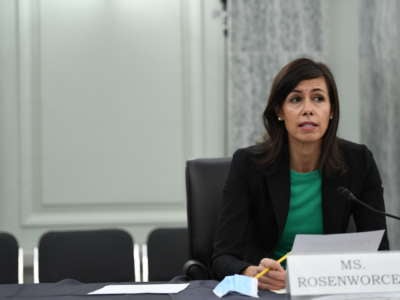A promise made by former President Joe Biden to connect millions of Americans to reliable and affordable high-speed internet service may become another casualty of President Donald Trump’s campaign to eliminate diversity, equity, and inclusion initiatives across the nation.
A top outgoing official at the U.S. Department of Commerce warned that funds for the Broadband, Equity, Access and Deployment Program, also known as BEAD, may be diverted to Trump adviser Elon Musk’s satellite internet company, Starlink. The BEAD program provides $42.5 billion to states and territories to build and deploy high-speed internet to underserved areas.
Evan Feinman, who until March 16 directed the program at the Commerce Department, wrote in an email last week that the broadband initiative — one of the centerpieces of the Infrastructure Investment and Jobs Act — was in jeopardy. Just days later, on March 18, Federal Communications Commissioner Geoffrey Starks resigned from his position, cutting short his term that was set to expire in 2027. Starks was one of two Democrats and only Black commissioner for the FCC.
Feinman argued that Starlink’s connections, which rely on Musk’s satellites, are inferior to using fiber optic cables, which is prioritized in the BEAD program.
“Stranding all or part of rural America with worse internet so that we can make the world’s richest man even richer is yet another in a long line of betrayals by Washington,” Feinman wrote in the email.
Politico first reported on Feinman’s email.
Expanding access to high-speed internet service, particularly in rural communities, is seen as a crucial step in alleviating the digital divide — the gap between those who can easily use, access, and afford technology, and those who cannot. Such disparities amplify the deep racial and economic inequalities in education, jobs, and health care for rural Black households in the South, where the greatest divide exists.
The BEAD program is also seen as a key element of promoting equity and leveling the technological playing field for communities of color.
However, there has been a lag in broadband deployment because of red tape, administrative delays, and the program’s affordability requirements. Digital equity advocates say that such delays were to be expected because the program’s initial timeline indicated it would take until 2026 to implement.
Technology experts like Mignon Clyburn, a former FCC commissioner and the first woman to serve as acting chair, also expressed worry that significantly altering the program could result in some marginalized populations being left behind — including veterans, seniors, and households with low incomes.
“My communities have been ignored for too long. I want sustainable, affordable, robust technologies. Those people don’t deserve to be cheapened. They deserve to have the best that our resources have to offer,” Clyburn said in an interview, emphasizing that the federal government needs to ensure “that the people currently on the wrong side of the technology divide do not stay there throughout several more lifetimes.”
Newly appointed Commerce Secretary Howard Lutnick called for a “rigorous review” of the BEAD program. He criticized Biden’s regulations for the program and emphasized the need to overhaul it with a “tech neutral approach” so that satellite services like Starlink could have a greater chance to participate in it.
In recent years, Republican lawmakers have condemned the program because of its DEI labor requirements and other factors. But some of their Republican colleagues have pushed back against their efforts while advocating for their states to continue the work.
In a statement, Lutnick said that he is adamant about “ripping out the Biden Administration’s pointless requirements.”
“The Department is exploring ways to cut government red tape that slows down infrastructure construction,” the statement read. “We will work with states and territories to quickly get rid of the delays and the waste.”
Threats Beyond One Program
While Trump administration officials appear to prefer satellite over fiber internet, multiple experts said satellite doesn’t fix the problem because it’s not affordable, nor does it work in all regions.
Starlink, which services 4 million people, uses satellites to connect internet service to dishes then to devices. Two years ago, the FCC denied Starlink’s application for $900 million in subsidies for rural broadband because the company did not meet the service requirements, according to The New York Times.
For residential service at homes, the price starts at $80 a month, according to its website. To assist those in need, the federal government created the Affordable Connectivity Program, which provided a discount of up to $30 per month ($75 for tribal households) toward internet service and mobile services, and a one-time discount up to $100 toward a laptop, desktop computer, or tablet for eligible low-income households. More than 23 million Americans were enrolled.
However, Congress did not reauthorize the program. Since the program ended, 40% of Americans cut spending on food to afford internet service, whereas 36% discontinued telehealth services, a recent survey by the National Lifeline Association found. At least 80% of those who were enrolled live at or below the poverty line. The only other program available is the FCC’s Lifeline Program, but recipients only receive a $9.25 monthly discount, which critics say isn’t enough.
If consumers can’t afford internet service, it undermines efforts to promote equity, said Brandon Forester, senior campaign lead at Media Justice.
“Having a low-cost option makes it more viable for an internet service provider to build out. That’s also true about having digital equity practitioners. If they have people in the community that are helping people sign up for their services and are helping people use their services, that’s a benefit,” Forester said. “If we’re getting rid of digital equity, that’s another loss. When the lights go on on these networks, is there going to be anybody there to connect to them? Maybe, maybe not.”
With the current program, installing fiber creates jobs and workforce development, which could be dismantled, said Alisa Valentin, broadband policy director at Public Knowledge. She also points to the hard work of state broadband offices and federal workers, and doesn’t want it to be in vain.
“We want to ensure that broadband is deployed where it is needed the most to avoid wasting time and resources. We want to get this right. This is a historic amount of funds that I’m so proud that we were able to come together across government, across public interest organizations, across industries to make sure that this happens,” she said. “We got to make sure we finish the job.”
Beyond BEAD, advocates and experts say there are threats looming for other programs and legislation, including the Digital Equity Act, which provides $2.75 billion to establish three grant programs that “promote digital equity and inclusion.”
The Digital Equity Act increases access to digital technology, education, and economic opportunities. The uncertainty is forcing states to cease work, questioning the future of their programming. For example, in Texas, the broadband office paused grants and contracts because of the Trump administration’s shift of federal priorities.
There are some states moving forward despite the uncertainties. Clyburn said she doesn’t foresee states rolling back the work they’ve done because they simply want to get to the finish line to connect communities, expand the workforce, build partnerships and “level the playing field,” and they shouldn’t be penalized over political bias.
This is the time for advocates to keep fighting and doing the work, said Kristenn Fortson, communications director for the National Digital Inclusion Alliance. The organization brings organizers to Washington to speak directly to lawmakers about their experiences and importance of these programs.
“It’s the grandfather who can now join his church virtually or FaceTime his grandchildren after being home bound for months. It’s incarcerated women who are being taught digital skills so they can build a resume and successfully reenter society,” Fortson said.
She added: “We know from the history of any movement centered on equity and equality that nobody can really guarantee that for us; we have to fight for it. We keep on pushing for it like anybody else who’s come before us, trying to make their communities a better place to live, a better place to thrive.”
We’re not backing down in the face of Trump’s threats.
As Donald Trump is inaugurated a second time, independent media organizations are faced with urgent mandates: Tell the truth more loudly than ever before. Do that work even as our standard modes of distribution (such as social media platforms) are being manipulated and curtailed by forces of fascist repression and ruthless capitalism. Do that work even as journalism and journalists face targeted attacks, including from the government itself. And do that work in community, never forgetting that we’re not shouting into a faceless void – we’re reaching out to real people amid a life-threatening political climate.
Our task is formidable, and it requires us to ground ourselves in our principles, remind ourselves of our utility, dig in and commit.
As a dizzying number of corporate news organizations – either through need or greed – rush to implement new ways to further monetize their content, and others acquiesce to Trump’s wishes, now is a time for movement media-makers to double down on community-first models.
At Truthout, we are reaffirming our commitments on this front: We won’t run ads or have a paywall because we believe that everyone should have access to information, and that access should exist without barriers and free of distractions from craven corporate interests. We recognize the implications for democracy when information-seekers click a link only to find the article trapped behind a paywall or buried on a page with dozens of invasive ads. The laws of capitalism dictate an unending increase in monetization, and much of the media simply follows those laws. Truthout and many of our peers are dedicating ourselves to following other paths – a commitment which feels vital in a moment when corporations are evermore overtly embedded in government.
Over 80 percent of Truthout‘s funding comes from small individual donations from our community of readers, and the remaining 20 percent comes from a handful of social justice-oriented foundations. Over a third of our total budget is supported by recurring monthly donors, many of whom give because they want to help us keep Truthout barrier-free for everyone.
You can help by giving today. Whether you can make a small monthly donation or a larger gift, Truthout only works with your support.
Read full article at source
Stay informed about this story by subscribing to our regular Newsletter


